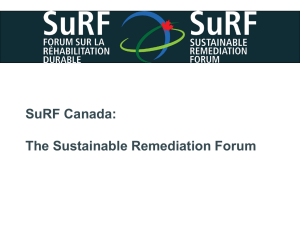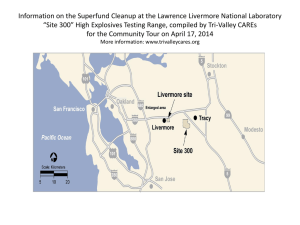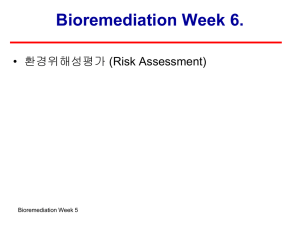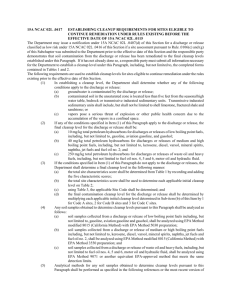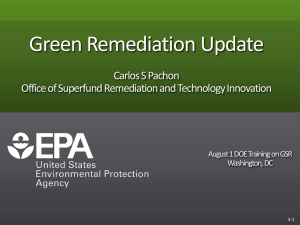Bioremediation Week3
advertisement
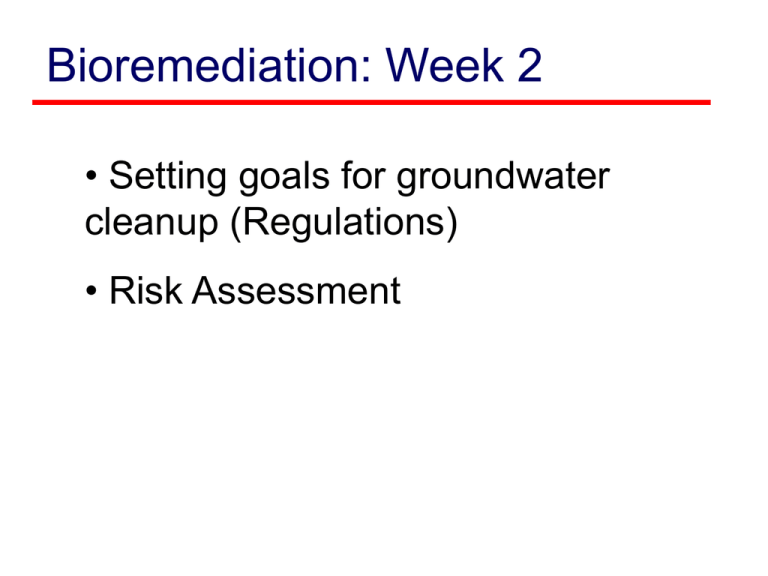
Bioremediation: Week 2 • Setting goals for groundwater cleanup (Regulations) • Risk Assessment Cleanup goals under CERCLA • National Contingency Plan (for the Superfund) Ground water cleanup goals should meet chemical-specific “applicable or relevant and appropriate requirements” from other regulations, known as ARARs. Drinking water standards: (1) The Safe Drinking Water Act (Maximum Contaminant Levels [MCLs]); (2) State drinking water standards. Direct discharges to surface water: must meet federal requirements (the Clean Water Act) Cleanup goals under CERCLA • National Contingency Plan (for the Superfund) Ground water cleanup goals should meet chemical-specific “applicable or relevant and appropriate requirements” from other regulations, known as ARARs. Drinking water standards: (1) The Safe Drinking Water Act (Maximum Contaminant Levels [MCLs]); (2) State drinking water standards. Direct discharges to surface water: must meet federal requirements (the Clean Water Act) •If no ARAR exists for a particular chemical, the ground water clean-up goal is based on risk assessment. In general, cleanup goals based on risk assessments must result in a risk level of 10-4 to 10-6 for carcinogens and a hazard index of less than 1 for noncarcinogens. Cleanup goals under CERCLA • Cleanup goals may be higher than MCLs if the aquifer is not useable for drinking (1) Aquifers cannot supply drinking water to a well or spring sufficient for the needs of an average family; (2) Ground waters are saline (more than 10g/L total dissolved solids) (3) Aquifers are otherwise contaminated from other sources beyond restoration using reasonable techniques. (4) If the goals are based on protecting a surface water body. Cleanup goals under CERCLA • Cleanup goals may be lower than MCLs for individual contaminants. (1) if multiple contaminants are present and the cumulative risk from all of them exceeds 10-4 for carcinogens or hazard index of 1 for noncarcinogens. (2) if the state in which the site is located has state-mandated MCLs or cleanup standards lower than the federals MCLs. Cleanup goals under CERCLA • Cleanup goals may be lower than MCLs for individual contaminants. (1) if multiple contaminants are present and the cumulative risk from all of them exceeds 10-4 for carcinogens or hazard index of 1 for noncarcinogens. (2) if the state in which the site is located has state-mandated MCLs or cleanup standards lower than the federals MCLs. • Under CERCLA, the EPA may waive health-based cleanup requirements where achieving them is “technically impracticable from an engineering perspective” => However, the EPA has been criticized for making minimum use of CERCLA’s statutory waiver provisions. Cleanup goals under RCRA • Corrective Action Rule. (1) No requirement to meet ARARs from other laws. (2) Generally more flexible than the CERCLA in allowing cleanup goals other than MCLs. (3) Alternate concentration limit (ACL) in place of drinking water (4) Nevertheless, the US EPA intends that RCRA and CERCLA should establish a consistent approach for ground water cleanup. => Therefore, under RCRA the EPA generally sets cleanup levels at MCLs. Alternative Cleanup Goals Resource Use Partially restricted Unrestricted Complete Cleanup to Cleanup to healthcleanup background level or based detection limit standards Cleanup to capabilities of current technology Cleanup to allow nonpotable uses (i.e., irrigation, recreation) Restricted Containment Alternative Cleanup Goals Resource Use Partially restricted Unrestricted Complete Cleanup to Cleanup to healthcleanup background level or based detection limit standards Cleanup to capabilities of current technology Cleanup to allow nonpotable uses (i.e., irrigation, recreation) Restricted Containment DISCUSSION: What would be the impacts of this relaxed goals in ENVIRONMENTAL INDUSTRY? Risk is Probability • Known to cause health problems to most of people. • Known to not cause health problems to most of people • Uncertain that a chemical is causing any health problems. • Which case is the “ultimate evil”? Risk Assessment • Epidemiologic and animal studies provide information about the types of health problems that may occur from contamination but they may be insufficient to determine the likelihood that health problems will occur in a given exposed pollutions. • To determine this likelihood, environmental regulators use a process known as risk assessment. Basic steps in risk assessment • Hazard identification: based upon the observations from epidemiologic and toxicologic studies. • Dose-response evaluation: based upon information extrapolated from high to low contaminant dose, small to large animals, and animals to humans. • Exposure evaluation: field characterization of contamination and the population. • Risk characterization: integration of information on the above factors. 환경위해성평가 • Risk Assessment - 서론 - 위해성 평가의 요소 - Hazard Identification (위험성 판별) - Dose-Response Assessment (용량-반응 평가) - Human Exposure Assessment (인체노출평가) 2015-04-09 CEE3330-01 Joonhong Park Copy Right Introduction • 미국 1980년대에 환경위해성평가가 환경정책에 반영되기 시작하였다. • 이러한 정책은 국민들이 환경위험에 대해서 경각심을 각기 시작했기 때문이다. (Rachael Carson, “Silent Spring”; Orange Agents for Vietnam War etc.) • 위해성 평가 (Risk Assessment): 노출과 보건/건강 간의 상관관계를 평가하기 위한 자료 수집과 분석 (과학적 관점) • 위해성 관리 (Risk Management): 위해성 평가에 근거해서 국가적 자원을 국민보건에 사용하는 것을 결정하는 의사결정과 행정적 집행 (정책적 관점) 2015-04-09 CEE3330-01 Joonhong Park Copy Right Perspectives on Risks • Risk (위해성)은 어떤 독성물질에 의해서 어떤 사람이 병이 걸리거나 심하면 죽을 수 있는 가능성 (probability) • Ex. 일년 사망자 중 암으로 죽을 확률 • Ex. 일년 사망자 중 교통사고로 죽을 확률 • 생물학적, 활동 및 습관 등 개인적인 차이가 많다. • When risks are based on models, there are generally very large uncertainties in the estimates. Perception on Risk • 노출위험에 처한 본인의 위해성을 알고 있는 경우에 비해서, 노출위험에 의한 위해성에 대해서 신뢰성 있는 정보가 없을때 더 위해하다고 느낌. • 예) 주유소 주면에서 살면 벤젠에 의한 발암율이 얼마인지 아는 경우에 비해서, 원자력 발전소 주면에서 살면 발생할 위해성에 대해서 모른 경우 더 불안해 함. Risk Assessment Causally linked to particular Health effects? How much of dose cause adverse health effect? Who will be exposed to the toxicants? (size and nature of populations) Integration of the above three steps to determine the magnitude of the public-health problem Hazard Identification Goal: 관심대상 물질이 우리 인체에 유해한가를 밝히는 것 (독성학적 관점) Pathways of Toxicant into Human Body: 1. 음식과 물을 먹고 마시는 것을 통해서 2. 호흡을 통해서 3. 피부와 신체외부기관을 통해서 Organ-Specific Toxicity (see =>) Side Effects by Toxic Chemicals 1. 중금속은 췌장/간 파괴 => 전신 2. 일산화탄소와 질산성질소는 혈액내 산소공급 방해 => 전신 3. 담배연기, 미세먼지 등이 허파에 문제 (나노입자의 신규문제) 4. 피부는 다양한 화학물질에 반응 (아토피) The circulatory system and nomenclature of toxic effects: hepatotoxicity (liver), nephrotoxicity (kidneys), pulmonotoxicity (lungs), hematotoxicity (blood). [Source: Based on James, 1985] Fate of toxicants in the body Fate of chemical toxicants in the body (Source: Environ. 1988) Hazard Identification • • • • 급성독성 파악 Acute Toxicity 유전자돌연변이 Mutagenesis 발암성 진단 Carcinogenesis 세균-동물 독성실험 Toxicity Testing in Animals • 인체독성실험 Human Studies • 발암물질 가능성 가중치 Weight-ofEvidence Categories for Potential Carcinogens Acute (급성) Toxicity • Philippus Aureolus Theophrastus Bombastus von Hohenheim-Paracelsus, “화학물질의 주입 양에 따라서 독인지 약인지가 결정된다”. Mutagenesis DNA (deoxyribonucleic acid) Carcinogens Teratogens Possible consequences of a mutagenic event in somatic and germinal cells Health Risks of Contaminated Ground Water •Animal Studies •Epidemiologic Studies Animal Studies • Provide estimates of the long-term human health effects of environmental contaminants based on the response of animals to large doses of the contaminant over relatively short time periods. • Regulators often must reply on animal studies. • Essential to a preventive approach to protecting public health. Toxicity Testing in Animal 1. 급성독성분석 2. 화학적 구조분석 3. 박테리아 독성분석 (Ames mutagenicity assays) 4. 동물기관을 이용한 독성분석 5. 동물을 이용한 독성분석 (chronic carcinogenesis bioassay) - 두 종이상의 쥐를 사용할 것 - 최소 수컷 50, 암컷 50을 사용할 것 - 최소 두 Dose 수준을 사용할 것 (max. tolerant dose [MTD] included) •LD50: lethal dose for 50% of the test population of the most sensitive species studied. •No observed effects (NOEL) at any biologically significant end point = LOEL (Lowest Observed Effects Level) / 10 (uncertainty factor) Extrapolating to Humans Assumption: humans can be 10 times more sensitive than the most sensitive study species Uncertainty Factor (UF) <1000 -Uncertainty of the study -Intraspecies variation -Interspecies variation (2-3 fold in general) -10 might be conservative. -Extrapolating from an acute or subchronic dose range to a chronic dose. Reference Dose (RfD): Permissible exposure levels. RfD = NOEL/UF Extrapolations from High Doses to Low Doses 고농도의 동물실험결과를 저농도 노출의 인체에 적용하는 것은 매우 힘든 일이고, 사실상 과학적으로 타당성을 찾기 힘들다. 이러한 외삽을 하는 것은 과학적이라기 보다는 정책적 관점과 필요에 의한 것. 많이 사용하는 외삽모델. 1) one-hit model: P(d) = 1 – exp(-q0 – q1d) P(d): risk (probability) as a function of dose (d) d: dose q0, q1: fitting parameters 2) Multistage model: P(d) =1-exp(-q0-q1d-q2d^2-qnd^n) 3) Linearized multistage model (US EPA) Hypothetical dose-response curves Shortcomings of Animal Studies • Must extrapolate effect observed in animals that are administered large doses of the contaminant to humans who will most likely receive much smaller does) • Different species may metabolize chemicals in different ways and therefore may be affected differently by chemical exposure. •The current animal studies focus on the effect of single chemical rather than the effects of mixed chemicals. Epidemiologic Studies • Determine health effects by examining specific populations exposed to the contaminants (either occupational groups or residents living near contaminated sites.) Limitations of Epidemiologic Studies • Limitations - Uncertain exposure - Latency - Small size of study population - Inadequate control over comparison groups - Uncertain health effects of the contaminant - Presence of contaminant mixtures - Confounding factors and sources of bias Human Studies 고농도와 동물실험의 경우는 인간과 인간에 노출된 저농도의 오염노출의 위해성과는 다른 것임. 이를 위해서 인간을 대상으로 한 실증결과가 필요 인간실증자료: (1) 오염누출사고 지역 (2) 역학조사 - Relative risk = [a/(a+b)] / [c/(c+d)] - Attributable risk = [a/(a+b)] - [c/(c+d)] - Odds ratio = ad/bc when its value is 1.0 Carcinogenesis (발암성) • 인류의 최대의 적: 암 • 초기단계: 독성물질이 DNA를 변형시켜서 조절이 되지 않는 세포의 성장이 시작하는 단계. • 발전단계: 유전적 변형이 생긴 세포가 자라서 혹을 형성하는 단계. • Metastasis: 암 혹이 몸의 다른 부위로 퍼지는 단계. Evidence of carcinogenicity •Evidence in humans from epidemiological studies •Evidence in short term in vitro tests •Strength of evidence from animal toxicity studies. •Type of tumor and how many (symptom and population toxicology) •Mechanism of action Dose-Response Assessment Hypothetical dose-response curves Weight-of-Evidence Categories for Potential Carcinogens (US EPA) Group A (Human Carcinogen): 신빙성있는 역학조사 결과, 인체 발암과 노출이 높은 상관성을 보이는 화학물질. Group B (Probable Human Carcinogen): 이는 두 그룹으로 구분됨. B1 역학자료는 다소 부족하나 발암 가능성을 보이는 경우; B2 역학자료는 발암가능성을 제시에 제한적이나 동물독성분석결과가 발암 증거를 제시하는 경우. Group C (Possible Human Carcinogen): 발암성에 대한 동물독성증거가 제한적이고 인체독성증거가 전무한 화학물질. Group D (Not Classified):동물과 인체에 대한 적절한 발암성 근거가 없는 화학물질. Group E (Evidence of Noncarcinogenicity): 두 종이상의 동물실험결과와 역학조사결과 발암성이 없다고 알려진 화학물질. Potency Factor for Carcinogens The potency factor (PF) is the slope of the dose-response curve. It can also be thought of as the risk that corresponds to a chronic daily intake of 1 mg/kg-day. Incremental lifetime cancer risk PF= Chronic daily intake [CDI](mg/kg-day) PF values can be found in an EPA database on toxic substances called the Integrated Risk Information System (IRIS). CDI (mg/kg-day) = Ave. daily dose (mg/day)/Body weight (kg) The Reference Dose for Noncarcinogenic Effects LOEL: the lowest-observed-effect level NOEL: no-observed-effect level NOAELs: no-observed-adverse-effect levels RfD: reference dose (acceptable daily intake [ADI]) The Hazard Index for Noncarcinogenic Effects Average daily dose during exposure period (mg/kg-day) Hazard quotient = RfD (for individual chemical) Hazard index = Sum of Hazard quotients for all the toxicants in environment Human Exposure Assessment Bioconcentration and Contaminant degradation Risk Characterization 위해성 특성화에 필요한 정보들 (미국 한림원 제안 사항, 1983) 건강에 미치는 영향에 대한 분석결과의 신뢰성에 대한 정보 생물학적 불확실성과 기원에 대한 정보 독성에 대한 측정방법에 대한 정보? 정량적으로 평가되는 독성요인들은 어떤 것이 있는가? 의사결정에 불확실성이 고려되는 방식은? 어떠한 dose-response assessments와 exposure assessments 방법이 사용되는가? 7. 어떠한 대상인구가 위해성관리에 우선적으로 고려되야 하는가? 8. 대상 위해성을 구체적으로 어떠한 용어로 표현할 것인가? 1. 2. 3. 4. 5. 6. Uncertainty in Risk Assessment • Existing evidence is insufficient to provide clear conclusions about the level of health risk posed by ground water and soil contamination. • Nevertheless, the absence of documentation of health risks cannot be used as proof that exposure and adverse health effect have not occurred. • Given the scientific uncertainties associated with epidemiology and risk assessment, public policy makers should err on the side of caution in setting ground water cleanup goals. Ecological Risks of Groundwater Contamination • At the Munisport landfill in FL, the EPA required a $6.2 million remedial action because of its impact on aqueous organisms (because of high salinity, the health-based standards were not applied.) • Impacts on Organisms in Groundwater • Impacts on Terrestrial Plants Economics of Groundwater Cleanup Policy stringency Removal % P resen t W o rth in D o lla rs Remediation method dependent 6000000 6000000 5000000 5000000 4000000 P resent 4000000 W orth in 3000000 D ollars 2000000 1000000 3000000 2000000 90% rem oval 99.9% rem oval 1000000 0 0 1 2 3 4 5 6 7 8 R etardation Factor 0 In situ conventional biorem ediation pum p-and-treat 9 10 90 % rem oval 99 % rem oval The Complexity of Selecting Cleanup Goals Purposes for use of ground water GW remediation technology Regulation policy GW Cleanup Goals Risk Assessment (human health) Economics Ecological Risk Assessment
